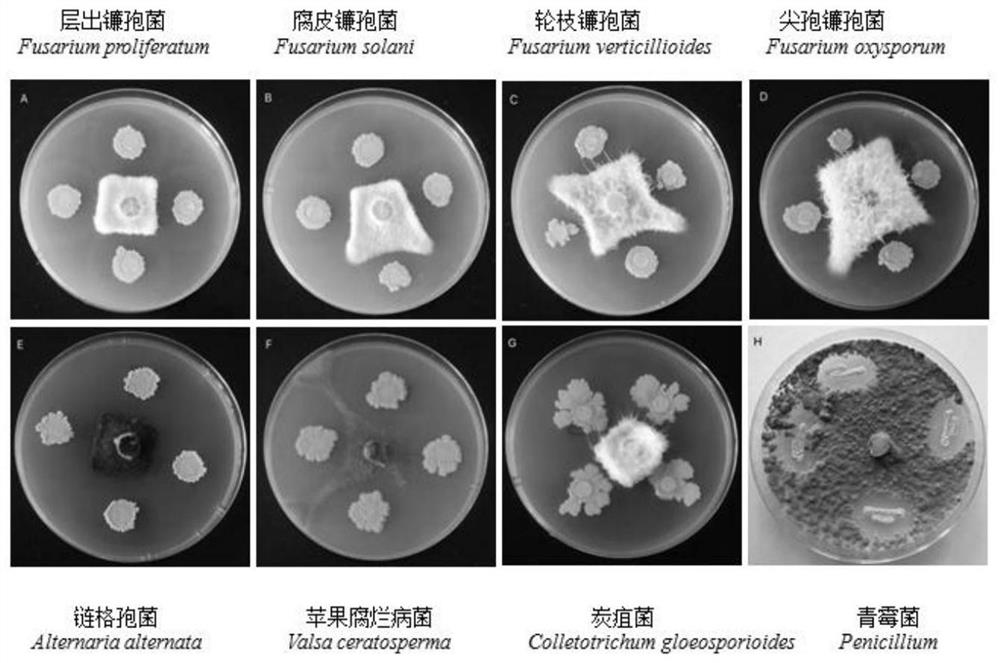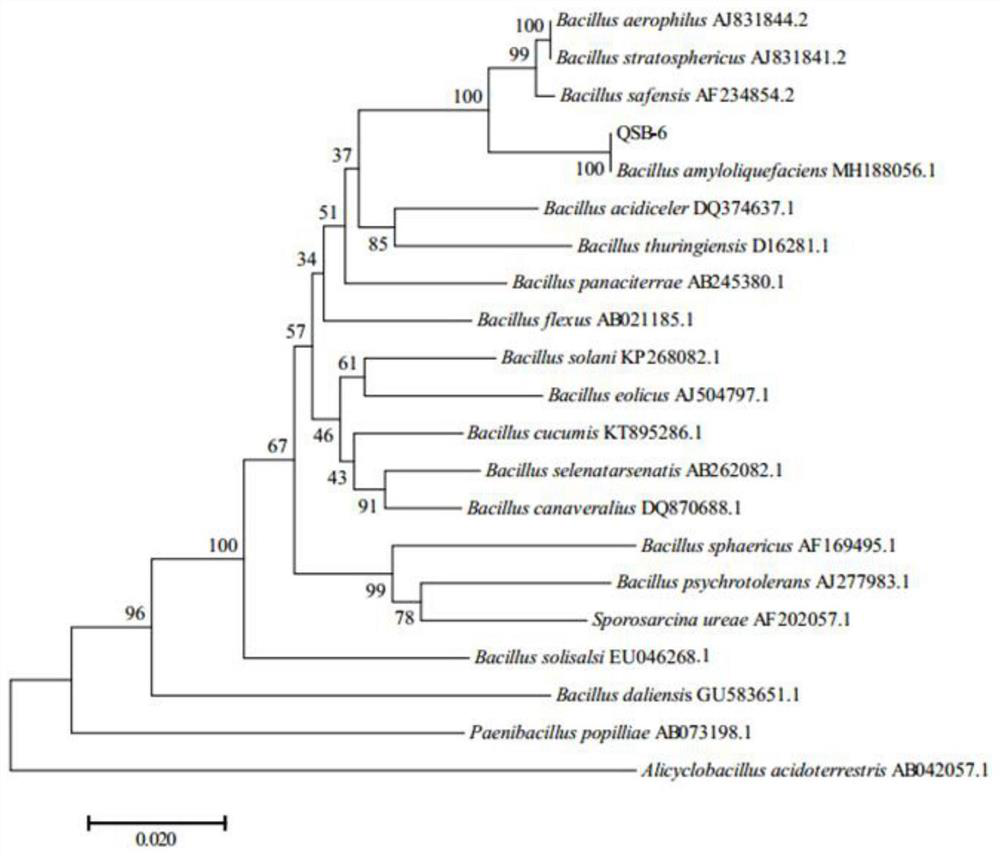Bacillus amyloliquefaciens strain and application thereof in prevention and treatment of apple continuous cropping obstacles
A technology of amyloliquefaciens and bacilli, applied in the field of agricultural microorganisms
- Summary
- Abstract
- Description
- Claims
- Application Information
AI Technical Summary
Problems solved by technology
Method used
Image
Examples
Embodiment 1
[0067] Example 1: Isolation and identification of bacterial strains
[0068] 1. Isolation and purification of strains:
[0069] Rhizosphere bacteria were isolated by a modified dilution spread plate method. Fresh soil samples were passed through a sieve with a diameter of 3-4 mm to remove impurities in the soil. Weigh 5 g of rhizosphere soil, add it to a triangular flask (with glass beads) filled with 45 mL of sterile water, vibrate at 180 rpm for 30 min, let it stand for 5 min, and serially dilute to 1×10 with sterile water. -4 100 μL of the supernatant of the gradient dilution was spread on the LB plate, repeated three times, and cultured upside down in a constant temperature incubator at 28°C. After a single colony grows in the plate, pick a single colony of different shapes and streak on a new LB plate for purification. At the same time, the purified strain was inoculated in liquid LB medium, shaken at 180rpm at 28°C for 12h, centrifuged at 10000r at 4°C for 10min, disc...
Embodiment 2
[0093] Embodiment 2: the broad-spectrum antibacterial effect of bacterial strain QSB-6
[0094] In order to further verify whether the QSB-6 strain has a broad-spectrum antibacterial effect on plant-derived diseases, another four common pathogenic fungi were selected for further antibacterial tests. The results are shown in Table 2.
[0095] The results of confrontation test showed that QSB-6 strain had a strong inhibitory effect on the growth of four kinds of pathogenic Fusarium mycelium. It also has a strong inhibitory effect on Penicillium citrus, Grape Anthracnose, Alternaria corn and Apple rot. Therefore, the strain QSB-6 has a broad-spectrum antibacterial effect on plant pathogenic bacteria under the conditions of the in vitro petri dish test.
[0096] Table 2: Inhibition effect of bacterial strain QSB-6 on 8 kinds of pathogenic bacteria
[0097]
[0098] Note: –, no zone of inhibition; +, zone of inhibition 10mm. Different lowercase letters indicate significant ...
Embodiment 3
[0099] Embodiment 3: the optimization of bacterial strain QSB-6 fermentation condition
[0100] 1. Test method:
[0101] The preserved strains were transferred to LB solid medium and cultured at 37°C for 24 hours. Pick the activated single colony and inoculate it into the Erlenmeyer flask containing 50ml LB liquid medium, 160r min -1 , 37 ° C shaker shaking culture until OD600 = 1 or so for use. The seed liquid is connected to the Erlenmeyer flask containing the culture medium according to the inoculation amount of 2%; at 200r·min-1 , Cultivate in a shaker at 37°C for 24h.
[0102] Fermentation culture studies with single factor experiments.
[0103] 1.1 Carbon source: use 20g·L respectively -1 Equal amounts of sucrose, maltose, glucose, lactose and soluble starch replaced the carbon source of the basal culture medium. After screening different concentrations of 0.1%, 0.5%, 1%, 1.5% and 2%, use shake flask fermentation culture, after 24h, determine the optimal carbon sour...
PUM
 Login to View More
Login to View More Abstract
Description
Claims
Application Information
 Login to View More
Login to View More - R&D Engineer
- R&D Manager
- IP Professional
- Industry Leading Data Capabilities
- Powerful AI technology
- Patent DNA Extraction
Browse by: Latest US Patents, China's latest patents, Technical Efficacy Thesaurus, Application Domain, Technology Topic, Popular Technical Reports.
© 2024 PatSnap. All rights reserved.Legal|Privacy policy|Modern Slavery Act Transparency Statement|Sitemap|About US| Contact US: help@patsnap.com










